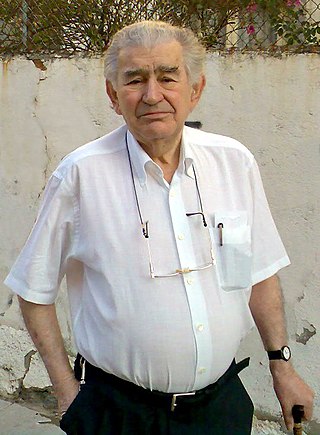Antonio Alatorre Vergara was a Mexican writer, philologist and translator, famous due to his influential academic essays about Spanish literature, and because of his book Los 1001 años de la lengua española.
Reo is a name appearing on Latin dedications to a Lusitanian-Gallaecian deity, usually with an epithet relating to a place, such as Reo Paramaeco discovered in Lugo in Galicia. The name Reo is in the Latin dative case, for a Latinized name *Reus.

Antonio Gamoneda Lobón is a Spanish poet, winner of the Cervantes Prize in 2006.

The Cornalvo Dam is a Roman gravity dam in Mérida, Badajoz province, Extremadura, Spain, dating to the 1st or 2nd century AD. The earth dam Roman concrete and stone cladding on the water face is still in use.

The Almonacid de la Cuba Dam was a Roman gravity dam in Almonacid de la Cuba, Zaragoza province, Aragon, Spain, dating to the 1st century AD.

The Proserpina Dam is a Roman gravity dam in Mérida, Extremadura, Spain, dating to the 1st or 2nd century AD. It was built as part of the infrastructure which supplied the city of Emerita Augusta with water.

The Alcantarilla Dam is a ruined Roman gravity dam in Mazarambroz, Toledo province, Castilla-La Mancha, Spain, dating to the 2nd century BC. The toponym "Alcantarilla" means conduit and is of Arabic origin: the Latin name is unknown.

The Muel Dam was a Roman gravity dam in Zaragoza province, Aragon, Spain, dating to the 1st century AD.

La Pared de los Moros was a Roman gravity dam in Teruel province, Aragon, Spain, dating to the 3rd century AD.

The Iturranduz Dam was a Roman buttress dam in Navarra, Spain. It consisted of two dams, one dating to the 2nd, the other to the 3rd or 4th century AD.

Diego Martínez Torrón is a professor of Spanish Literature at the University of Córdoba, Spain, and a writer, author of essays, poetry and novels. He has been a speaker at many of the major universities in Europe and the United States. A specialist in nineteenth and twentieth century Spanish literature he has published numerous books on Spanish Romanticism, with interpretive contributions and unpublished texts. He has edited the most faithful edition of the complete works of authors such as José de Espronceda and the Duque de Rivas. He has also written about Lista and Quintana and the work of Spanish progressive liberals from the early nineteenth century to the end of the period of Romanticism. He has studied the poetic thought of Juan Ramón, Octavio Paz and José Bergamin. He has also dedicated numerous studies to the works of Cervantes. He has studied the narrative of Álvaro Cunqueiro, Juan Benet, Azorín and has published the first annotated edition of El Ruedo Ibérico of Valle-Inclán. His concept of literary methodology stems from a new, non-Marxist approach to the binomial ideology and literature. He has edited Don Quixote, studying the thinking of Cervantes.

Eduardo Saavedra y Moragas, Spanish engineer, architect, archaeologist and Arabist, member of the Real Academia de la Historia, Spanish Royal Academy of Sciences, Real Academia Española and cofounder-president of the Real Sociedad Geográfica.

The Puente Río Portugués is a historic bridge over the former course of the Río Portugués in barrio Playa in the municipality of Ponce, Puerto Rico. The bridge was added to the U.S. National Register of Historic Places in 2015. The bridge is prominent as "the oldest longitudinal steel beams / reinforced concrete bridge built within the historic Carretera Central". It is located on Avenida Hostos, just south of its intersection with Ponce By Pass.

The first government of Adolfo Suárez was formed on 8 July 1976, following the latter's appointment as Prime Minister of Spain by King Juan Carlos I on 3 July and his swearing-in on 5 July, as a result of Carlos Arias Navarro's resignation from the post on 1 July 1976. It succeeded the second Arias Navarro government and was the Government of Spain from 8 July 1976 to 5 July 1977, a total of 362 days, or 11 months and 27 days.

The Heraldo de Madrid was a Spanish daily newspaper published from 1890 to 1939, with an evening circulation. It came to espouse a Republican leaning in its later spell.

The Praga Bridge is a bridge in Madrid, Spain. Crossing over the Manzanares, it is part of the Paseo de Santa María de la Cabeza, that eventually becomes the A-42 south of the river.
Juan María Guelbenzu Fernández was a Spanish pianist and composer.















